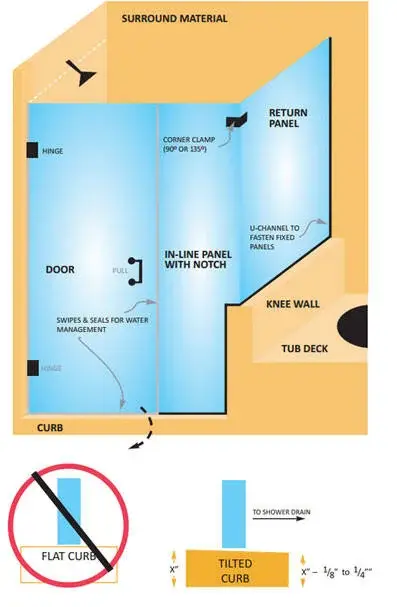Shower Design Tips
Shower Design Tips
Welcome to our comprehensive guide on designing your shower during a bathroom remodel, with a specific focus on ensuring compatibility with glass doors. Glass doors can add a touch of elegance and functionality to your shower space, but proper planning is crucial to ensure they work seamlessly within your design.
When considering glass doors for your shower, there are some key tips to keep in mind
Optimal Planning for Frameless Shower Enclosures: Size, Shape, Door Swing, and Location
To ensure a worry-free, leak-free, and easy-to-maintain frameless shower enclosure, it is essential to plan ahead with precision. Taking into account factors such as size, shape, door swing, and location will contribute to the effectiveness of managing water splash while maximizing functionality and aesthetics.
Consider the following guidelines for planning your frameless enclosure:
Size and Shape
The dimensions of your shower greatly impact the enclosure's ability to handle water splash effectively. For optimal results, we recommend a depth of at least 42" and a width of 48". In the case of neo-angled showers, a minimum size of 54" x 54" is advisable. Keep in mind that smaller showers may encounter water retention issues with a frameless enclosure.
Door Location and Swing
Plan the location of your shower door strategically to ensure easy access to water controls upon opening. Building codes typically require shower doors to open outward, so ensure there is ample swing room outside the shower. For single doors, widths between 28" and 36" are recommended. If wider access is desired, double doors can be considered.
Water Management
To optimize water management, position your shower head in a way that avoids direct spray onto the door. This helps minimize water leakage and keeps the enclosure dry. Additionally, ensure that the top of your shower glass reaches a height equal to or greater than the shower head. A general rule is to aim for a height of 80" above the shower curb, similar to the top of trim found above standard interior doors. Take into account surrounding materials and architectural features to determine the most aesthetically pleasing height for your glass enclosure.
Steam Enclosures
In the case of steam enclosures, the glass should extend all the way to the ceiling or a soffit. Both options should be surfaced with tile or other water-resistant materials, avoiding painted sheetrock. This ensures proper containment of steam and prevents damage to the surrounding areas.
By following these guidelines and planning meticulously, you can create an ideal frameless shower enclosure that delivers both functionality and visual appeal. Enjoy a hassle-free and visually stunning shower experience that perfectly complements your bathroom design.
Don't wait, contact us now to schedule your consultation!
Designing Glass, Hardware, Finishes, and Ease of Use
When designing a frameless glass enclosure, several factors come into play, including the type of glass, hardware selection, finishes, and considerations for ease of use. Let’s explore these elements in detail:
Glass Selection
Most frameless glass enclosures utilize tempered 3/8" glass, which strikes a balance between durability and elegance. For taller enclosures beyond the typical height, 1/2" thick glass is a suitable choice. While 3/8" glass offers a wide range of textures, exceptionally tall showers benefit from the added strength of 1/2" glass.
Textured Glass Options
The choice of textured glass can significantly impact the overall aesthetic of your bathroom. From transparent glass that appears almost invisible to geometric and organic patterns for decorative effects, and neutral designs for complete privacy, there is a diverse range of options available. For a truly personalized touch, consider custom sandblasted designs.
Hardware Selection
The hardware used in your enclosure plays a vital role in its final appearance. Hinges, pulls, clamps, towel bars, and hooks come in various styles, ranging from traditional elegance to sleek minimalism, and even industrial or Victorian designs, with many transitional options in between. Choose hardware that complements your desired aesthetic.
Finishes
All standard plumbing finishes are available for shower hardware, and you can even custom-match newly introduced finishes. Keep in mind that custom-matching a finish may require an extended lead time and incur an additional cost.
Ease of Use and Daily Convenience
Select pulls, towel bars, and other accessory hardware with ease of use and daily convenience in mind. Consider incorporating a through-the-glass towel hook for added functionality, ensuring your towel is within easy reach instead of being located across the room.
Enhanced Storage Space
Explore the option of visually light and airy glass shelving to expand storage space both inside and outside the shower. These shelves can provide a practical and stylish solution for organizing shower essentials.
By carefully considering these design elements, you can create a frameless glass enclosure that not only meets your aesthetic preferences but also enhances the functionality and convenience of your bathroom space.
Don't wait, contact us now to schedule your consultation!

Surface Choices, Wall Angles, and Curb Tilt for Building
To ensure a well-designed and functional shower, it is essential to consider building surface choices, wall angles, and curb tilt. Let’s explore these aspects in detail:
Building Surface Choices
When attaching glass, particularly on horizontal planes, we recommend using solid surface materials. Opting for smooth surfaces eliminates grout lines where water can collect. You can choose from a range of options, including stone, Corian, marble, and Silestone, which come in various colors, allowing you to find the perfect match for your shower.
Wall Angles
When framing your shower, it is crucial that all wall surfaces intersect with the glass planes at a 90° angle. This is particularly important for neo-angle showers constructed using 135° walls. Ensuring precise right angles contributes to the structural integrity and aesthetic appeal of the shower enclosure.
Curb Tilt
The curbs of your shower should have a slight tilt towards the shower drain. We recommend a minimum tilt of 1/8" and a maximum tilt of 1/4" over the typical 4-5" width of the curb. This slope facilitates proper drainage, preventing water from pooling on the curb and improving overall water management within the shower space.
Shower Seats and Benches
If your shower includes seats or benches, it is important to ensure they are also slightly tilted to shed water toward the drain. This tilt promotes effective water runoff, maintaining a clean and safe showering environment.
By carefully considering these factors during the building process, you can create a shower that not only looks visually appealing but also functions optimally. Choose solid surface materials, ensure proper wall angles, and incorporate suitable curb tilt and seating tilt to enhance the durability, functionality, and water management of your shower.
Extremely Important
Dos and Don'ts for Shower Design
To ensure a successful shower design, it’s important to follow certain guidelines. Here are some helpful dos and don’ts to consider:
DOs
- DO choose a smooth solid surface material for the horizontal surfaces of curbs and knee-walls. This eliminates grout lines where water can collect, ensuring easier maintenance and preventing water-related issues.
- DO plan for a door width of at least 28" and no more than 36". This range provides a comfortable and practical entry point for the shower.
- DO build your walls at 90 degrees to the planes of glass. This ensures a precise and visually appealing alignment between the walls and the glass surfaces.
- DO tilt your curb slightly towards the shower drain. This slope facilitates proper drainage and helps prevent water from pooling on the curb.
DON'Ts
- DON'T have a relief accent tile run through the plane of glass. This can disrupt the clean and seamless look of the glass enclosure. Instead, consider using accent tiles on the wall surfaces adjacent to the glass
Minimums and Maximums
- The minimum width for a glass panel should be 4″. This ensures structural stability and proper functionality.
- The maximum panel size should not exceed 40 square feet. Larger panels may compromise the integrity of the glass and could be challenging to install.
- For door width, the maximum recommended size is 36″. This ensures ease of use and proper functionality for entering and exiting the shower.
By following these guidelines, you can create a well-designed and functional shower space that meets your needs and enhances your overall bathroom experience.

